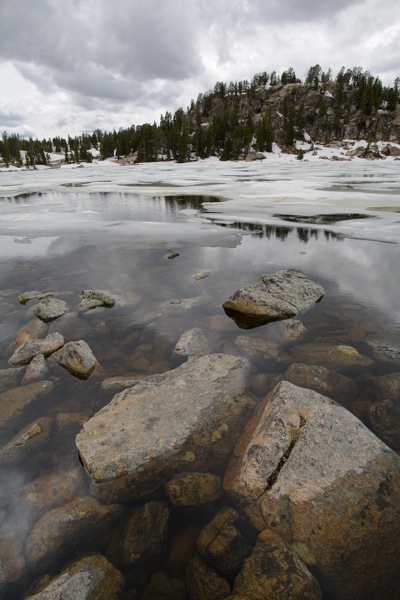Using Wide-Angle to Add Foreground
It was a cold day in early June along the Beartooth Highway. We were somewhere between 8000’ and 10000’ in elevation, and the snow and clouds painted a bleak scene. There were many directions I could point my camera and get nearly the same picture — one which would hold little interest. I would have liked to have blue skies with a few puffy white cumulous clouds, but this was my only day to be there and I had to play the cards that were dealt. It is especially at times like this that I resort to one of my favorite lenses: a wide-angle zoom. The angular gathering power of the lens gives me an opportunity to turn a level or even low-angle shot into a high-angle shot (aiming downward). I put the horizon higher in the picture, and aim down to add to the bottom of the picture some interesting elements in the near and very near foreground (being careful to not add my shoes or tripod legs to the picture). What might otherwise have been the subject (the rocky mound with trees) has become background to the rocks sticking out of the water. These foreground rocks added something interesting compositionally, and their form helped complete our understanding of the shapes of the rocks toward the back of the scene. The colors of the foreground rocks, while not very saturated, added a nice compliment to the otherwise monochromatic scene. The shapes and colors of the rocks just below the water line provided a peak into a world often obscured by glare. Instead of being a picture about a rocky mound with trees and a lake in the foreground, this became a picture about forms and subtle tones, about a mood, about questions regarding the geological forces that created this terrain, and about a microcosm set against a macrocosm.
Working with subjects that are so close to the camera, small movements in the camera’s position and orientation have an huge effect on the overall composition of the image. Typically, I’ll walk around a little from side to side, picking the point of view that most captures the mood of the place. Then I’ll bring in the tripod, mount the camera, and then simultaneously adjust the downward angle of the camera while “dialing in” the amount of wide-angle I want — usually controlling what elements I want at the edges of the image. Recognizing that the wide-angle is going to give you lots of inherent depth-of-field, you might be tempted to skip the cumbersome tripod and just shoot hand-held. The tripod does a few things for you that are quite worth the trouble: (1) It fixes your camera’s position and orientation, which helps you control your composition (remember, composition is strongly affected by even small movements in the camera when you have objects close to the camera). (2) It allows you to use the best aperture to get the depth-of-field you want, even if the shutter speed might be slow. Sometimes you might want the background to be sharp as well, in which case you’ll want a smaller aperture. (3) It gives you time to set up your shot, fix the composition, and then wait for the right moment when the clouds look most interesting, or a raindrop has just hit the water, or a breeze has paused long enough to give the water the smooth and glassy surface desired for reflecting sky and background.
This shot was done with a Canon EF 20-35mm f/2.8L lens at the 20mm focal length, with the exposure set to 1/100s at f/11.

Tip of the Week
2007.01.08

